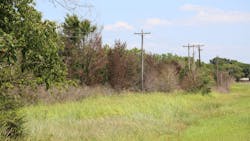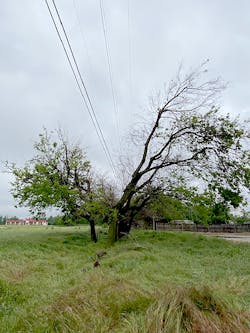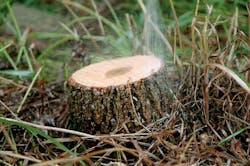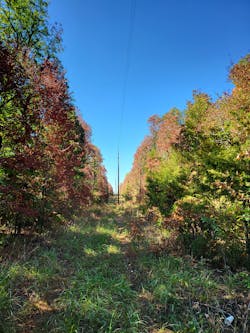IVM: A Blueprint for Continuous Improvement
Chemical control strategies helped OG&E enhance the control of undesirable woody plants. However, the formulations and treatment methods used to support herbicide applications 30 years ago were far less selective than they are today, which periodically contributed to off-target control issues for the investor-owned utility. Similarly, mechanical control methods damaged desirable plants, including plum, sumac, honeysuckle and other compatible tree species.
The mowing and tree-trimming practices employed by OG&E also stimulated regrowth and seed spreading for targeted plants. These adverse effects gradually increased maintenance requirements and associated costs, which reduced the amount of budget available for herbicide treatments. Eventually, all resources were reallocated to help the utility keep up with trimming and mowing maintenance demands.
Reverting to trimming and mowing as primary vegetation control strategies proved costly for OG&E. Without the help of selective herbicide applications, the utility saw incompatible plants return in full force, reducing visibility for aerial transmission line inspections and limiting site accessibility for distribution and transmission maintenance crews. These recurring issues ultimately led the utility to reintegrate selective herbicides as its chief strategy for vegetation control.
“We learned that working exclusively with tree and mowing crews is likely to lead to higher stem counts,” said Shawn Huff, supervisor of vegetation management for OG&E. “They can only do so much, and they only deal with immediate problems — not future problems. We can’t even come close to achieving our goals without herbicides.”
A New Beginning with IVM
Since 2019, OG&E has used a variety of chemical control strategies as part of the utility’s integrated vegetation management (IVM) program. This approach is structured to enhance mechanical mowing results and mitigate some of the most prevalent threats to electrical service reliability throughout the utility’s 30,000 square-mile transmission and distribution service territory. After initially using high-volume foliar applications to reclaim areas filled with dense and incompatible brush species, OG&E and contract partners integrated the following herbicide applications to further refine the utility’s IVM-based approach:
- Ultra-low volume wire zone spray trimming and chemical side-trim applications to selectively control limbs or sections of trees posing a threat to service reliability
- Tree growth regulator applications to control regrowth in trimmed trees
- Bareground applications to control all vegetation on substations, including persistent thistle species
A few months after application, Quality Assurance (QA) teams audit each treatment site to confirm the targeted area received 100% coverage. QA then audits treatment sites the following year to determine if applications achieved the utility’s goal of 90% control.
Field results have shown that foliar season applications used by OG&E have helped Oklahoma’s largest investor-owned utility reduce the need for tree-trimming practices. While tree crews still work in urban and rural areas to control overhanging limbs or heavy growth impacting minimum approach distance to energized wires, licensed personnel now follow those treatments with a variety of selective herbicide applications to enhance easement reclamation.
“We are seeing a phenomenal return on investment with our dormant-season work,” he says. “Since we can do those treatments at any time of the year, we’re not as restricted to tight treatment windows.”
Applying low-volume basal bark, cut-stump and cut-stubble treatments throughout the dormant season helps OG&E control incompatible brush species. As a result, the utility’s contract partners can keep working throughout the winter months and enhance the future control of brush-sized tree species without sacrificing cost efficiency.
“We’re able to cover thousands of miles during the dormant season,” Huff says. “We’re talking tens of thousands of stems that are now controlled and no longer a problem for us. We’ve had zero complaints with our dormant-season work, and we’re able to treat at a very low cost per mile. We just can’t get that with the tree crews.”
Strengthening a Grass-Friendly Approach
Unlike nonselective control methods, selective herbicide applications and grass-friendly brush mixes can help utility vegetation managers create barriers against woody plants and reduce off-target control risks. This supports the development of grasses and small forbs that prevent woody plant seed germination and provide habitat for small mammals that consume the seeds of incompatible brush species.
Results from long-standing environmental research studies also indicate the potential benefits IVM programs can provide throughout utility ROW. Findings from the State Game Lands 33 (SGL 33) research project, which has studied the ecological impact of various vegetation management strategies on utility ROW for nearly 70 years, show how using selective herbicide applications as part of an IVM-based approach can successfully lower viable woody plant seed germination by as much as 88%. These results yield landscapes in which low-growing native plant communities can thrive.
“IVM is a system of land management processes for establishing compatible plant communities,” says Darrell Russell, market development specialist, Corteva Agriscience. “While mowing exclusively can impede native plant development, targeted applications of selective herbicides support this desirable vegetation by selectively controlling incompatible trees and brush species. This ‘grass-friendly’ approach creates landscapes in which beneficial grasses and forbs can thrive.”
As a long-time funding partner of SGL 33, Corteva uses results from the extensive environmental study to help OG&E and other utilities develop treatment plans and communications tactics that keep all entities strategically aligned.
“The most value I get from Corteva is in the training, knowledge and resources they provide to help us understand what is taking place out in the field,” Huff said. “From applicators and planners to foresters, myself and those above me, they’re embedded in our program across the board.”
In recent years, Corteva’s vegetation management specialists have helped Huff identify different chemistries and selective tank mixes to enhance results and cost-efficiency for the OG&E program. This support has included the introduction of a foundational mix for grass-friendly brush control as well as product and tank-mix recommendations to enhance results for chemical side-trim, basal bark and cut-stump treatments used by the utility.
“We’re able to get ahead of public concerns by simply educating our partners on the products and strategies we want them to use,” Huff said. “Our applicators are also well-educated on tank mixes, which allows them to talk through landowner concerns.”
As Huff indicates, educational opportunities provided to program partners help OG&E improve not only results in the field, but also public perception.
Improving Landowner Relations
Utility companies commonly encounter varying degrees of public scrutiny. From infrastructure disputes to environmental concerns, today’s utilities are often judged on misperception or misunderstanding — especially when herbicide applications are the topic of discussion. However, Huff has learned that simply explaining how selective herbicide applications enhance service reliability and environmental sustainability can pay dividends for practitioners when addressing customer concerns.
“People just want more information,” Huff said. “Once we’ve provided it to them, they’re usually more comfortable with what we’re doing.”
This notion increases the value of the grass-friendly approach OG&E has strengthened over the past few years. Chemical side-trim applications and dormant-season treatments used by the utility have reduced brownout effects and minimized off-target control issues. As these strategies also support the development of beneficial grasses and forbs, OG&E has been able to limit the potential for landowner complaints.
“I’ve spoken with property owners who may not agree with the fact that we’ve controlled their tree, but when they understand our thought process and see that the grass is still there the following year, it makes a huge difference,” Huff said. “It’s hard to stand there when everything’s browned-out and we can’t say that we didn’t hurt the grass. Thanks to the herbicide treatments we’re using now, we’ve gotten a lot better at handling those types of complaints.”
Supporting the development of low-growing native plant communities also enhances long-standing biodiversity initiatives OG&E has worked on to preserve and expand habitat for native wildlife. In fact, when representatives with the State of Oklahoma found the frosted elfin butterfly (Callophrys irus) along with wild indigo on one of the utility’s solar farms last year, OG&E applied herbicides to remove incompatible vegetation before planting more wild indigo to develop additional habitat for the endangered pollinator species.
“After finding a new colony that nobody knew existed, we disturbed the environment the least amount possible,” Huff said. “The frosted elfin butterfly benefited from that greatly, and it solidified with our environmental group that we’re approaching vegetation management the right way.”
Resetting Industry Standards
From budget restrictions and landowner concerns to skilled labor shortages and program efficacy issues, a variety of formidable challenges can impact the success of UVM programs from one year to the next. But as far as Huff is concerned, IVM strategies featuring selective herbicide applications represent best management practices for industry leaders looking for ways to improve results and program flexibility in the near and distant future.
“It’s a minor increase in costs upfront, but the long-term benefits are huge,” Huff says. “When we have retractions in our budget, I cut zero dollars from our herbicide business. The benefit of getting that work done is so great that I’d rather have fewer tree crews than fewer herbicide crews. It’s more important for me that I get that work done.”
Editor’s Note: To learn more about successful herbicide programs and management techniques that help utility vegetation managers enhance service reliability and beneficial wildlife habitat, visit HabitatWithHerbicides.com.
Grant Ehlen ([email protected] ) is a vegetation management supervisor with Oklahoma Gas & Electric (OG&E). Equipped with a master’s degree in forest resource management from Oklahoma State University, and more than 35 years of experience in forestry and vegetation management, Ehlen oversees the vegetation management Quality Assurance program for OG&E, which currently has nearly 860,000 customers.
Lucas Madison ([email protected]) is a vegetation management specialist with Corteva Agriscience. Madison uses more than 13 years of experience with forestry and agricultural solutions to provide technical support, product recommendations and industry best practices to vegetation management customers throughout Arkansas, Missouri and Oklahoma. He is based in northern Arkansas.
About the Author
Lucas Madison
Lucas Madison ([email protected]) is a vegetation management specialist with Corteva Agriscience. Madison uses more than 13 years of experience with forestry and agricultural solutions to provide technical support, product recommendations and industry best practices to vegetation management customers throughout Arkansas, Missouri and Oklahoma. He is based in northern Arkansas.
Grant Ehlen
Grant Ehlen ([email protected] ) is a vegetation management supervisor with Oklahoma Gas & Electric (OG&E). Equipped with a master’s degree in forest resource management from Oklahoma State University, and more than 35 years of experience in forestry and vegetation management, Ehlen oversees the vegetation management Quality Assurance program for OG&E, which currently has nearly 860,000 customers.



